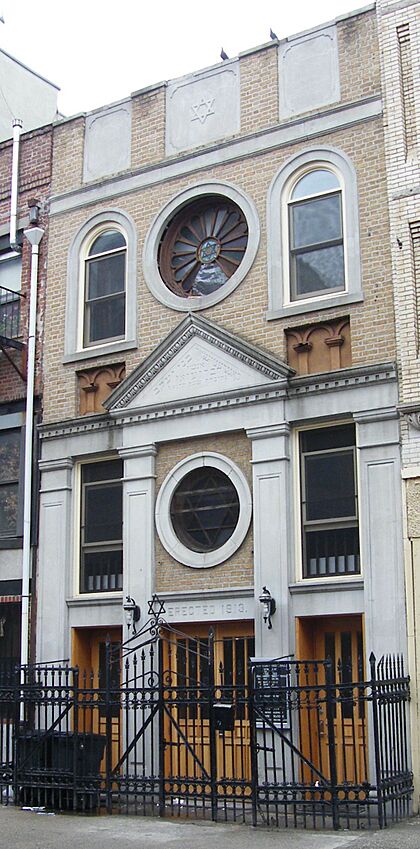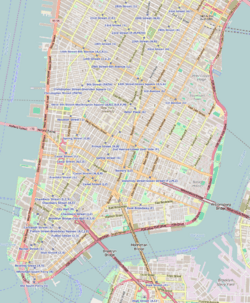Stanton Street Synagogue facts for kids
Quick facts for kids Stanton Street Synagogue |
|
|---|---|
|
Yiddish: קאנגרעגיישאן בני יעקב אנשי ברזעזאן
|
|

Stanton Street Shul in 2009
|
|
| Religion | |
| Affiliation | Orthodox Judaism |
| Ecclesiastical or organizational status | Synagogue |
| Leadership | Rabbi Aviad Bodner |
| Status | Active |
| Location | |
| Location | 180 Stanton Street, Lower East Side, Manhattan, New York City, New York 10002 |
| Country | United States |
| Architecture | |
| Architect(s) | Louis A. Sheinart |
| Architectural type | Synagogue |
| Architectural style | Neoclassical |
| Date established | 1894 (as a congregation) |
| Specifications | |
| Length | 100 feet (30 m) |
| Width | 20 feet (6.1 m) |
| Materials | Stone and brick |
The Stanton Street Synagogue, also known as the Stanton Street Shul, is an Orthodox Jewish synagogue in New York City. It is located at 180 Stanton Street on the Lower East Side of Manhattan.
This synagogue was built in 1913 by a group of Jewish immigrants. They came from a town called Brzeżany in a region once known as Galicia. Rabbi Judah Leib Rose, who arrived in New York in 1909, encouraged the community to build this special place.
The Stanton Street Synagogue is one of the few remaining synagogues built in the style of a tenement building. It was added to the National Register of Historic Places in 2002. Around that time, there was a disagreement about selling the building. However, the synagogue was saved, and new people became interested in joining. By 2012, it had about 100 members of all ages.
Contents
A Special Building's History
How the Synagogue Started
Jewish immigrants from Brzeżany in Galicia formed a group in 1894. They called themselves Congregation Bnai Jacob Anshei Brzezan. This group was a mutual aid society, meaning they helped each other.
They built their synagogue on Stanton Street in 1913. Rabbi Judah Leib Rose encouraged them to do this. The building used parts of two older structures from the 1840s. It cost $10,000 to build.
Changes Over Time
After the 1930s, fewer Jewish people lived on the Lower East Side. This meant fewer members for the synagogue. In 1952, the synagogue joined with another group called Bnai Joseph Dugel Macheneh Ephraim. This group was started by Polish-Jewish immigrants.
In 1964, Rabbi Joseph Singer became the spiritual leader. He was from Poland and had come to the Lower East Side in 1939. Rabbi Singer helped the poor and elderly people in the neighborhood for many years, often without pay.
Saving the Synagogue
By 2000, many of the older members had passed away or moved. It became hard to gather a minyan, which is a group of ten men needed for prayer services. Rabbi Singer sometimes offered food to encourage people to come.
In 2000, there was a plan to sell the synagogue building. The building was old and needed repairs. Rabbi Singer and some board members planned to sell it for $1.2 million. They did not tell the congregation about the sale until 2001.
The members were very upset and fought against the sale. The Torah scrolls, which are very important holy books, were even removed from the synagogue. The members went to a rabbinical court and then to the New York State Supreme Court.
In October 2002, everyone agreed that the building would not be sold. The Torah scrolls were returned. This event brought new attention and younger members to the synagogue.
A New Chapter Begins
After the sale was stopped, new leaders were chosen for the synagogue. They started getting money to make repairs. By 2004, the synagogue had over 100 members. These members included older people who spoke Yiddish and many younger couples and families. By 2012, most members were under 35 years old.
Since 2002, several rabbis have led the synagogue. Rabbi Akiva Herzfeld was the part-time rabbi in 2002. Rabbi Yossi Pollak followed him in 2006. In 2008, Rabbi Josh Yuter became the rabbi. He used his computer skills to help the synagogue, like using social media.
In 2014, Rabbi Aviad Bodner became the new rabbi. He had studied law and received his rabbinic ordination in Israel. Under his leadership, the number of members grew from about 30 to over 100.
Design and Features
What the Building Looks Like
The Stanton Street Synagogue is one of the last synagogues on the Lower East Side built in the tenement style. It is a three-story building made of stone and brick. It sits on a typical city lot, about 20 feet wide and 100 feet long.
The front of the building has a neoclassical design. It has four tall stone pilasters that support a decorative top part. The synagogue's Yiddish name and the year it was built are carved there.
The Star of David symbol appears in four places on the building. You can see it above the main entrance, in a large stained-glass window, carved on a stone tablet, and on the iron gate.
Inside the Synagogue
When you enter, stairs lead down to the main prayer area and a hall for gatherings. In the center of the prayer area is a wooden bimah, which is a platform for reading. The wooden Ark, where the Torah scrolls are kept, is at the front.
The ceiling of the prayer area is made of tin, and there are two skylight domes. There is also a women's gallery on two sides, but it is not used anymore. Instead of long benches, people sit on old school desk-chairs from the early 1900s.
Unique Art and Renovations
The walls around the main prayer area have paintings of the Zodiac signs. These signs represent the twelve Hebrew months. Zodiac art was common in old synagogues on the Lower East Side. Now, you can only see it at the Stanton Street Synagogue and the Bialystoker Synagogue.
Some of the wall paintings look like marble pillars, but they are actually trompe-l'œil art, which means "trick of the eye." The wall around the Ark has folk art paintings of the Tower of David and Rachel's Tomb.
The roof and fire escape were fixed in 2006 and 2007. The main prayer area was also renovated in 2007. In 2018, more repairs were made to the roof, back wall, and main sanctuary. Community members and artists helped restore some of the wall paintings. The synagogue always needs some repairs because it is an old building.
Activities and Community
The Stanton Street Synagogue welcomes different kinds of Jewish culture. It often hosts musical performances and other events. These events include traditional Jewish music, Jewish rock 'n' roll, and jazz. The synagogue has also shown art exhibitions. For example, in 2004, an artist created paintings using borsch juice and coffee grounds as a tribute to an older member.
Since 2004, the synagogue has held an annual event to remember the victims of the Triangle Shirtwaist Factory fire from 1911. Artists and synagogue members write the victims' names in chalk in front of their old homes.
In 2015, the Stanton Street Shul started a monthly "Stanton Kids tefila." This is a special prayer service for children. It includes guided prayers, singing, kid-friendly food, and a special talk from the rabbi.
See also
 In Spanish: Sinagoga de la Calle Stanton para niños
In Spanish: Sinagoga de la Calle Stanton para niños


